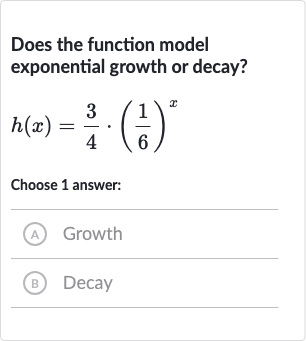Full solution
Q. Does the function model exponential growth or decay?Choose answer:(A) Growth(B) Decay
- Identify base: Step : Identify the base of the exponential function. In the function , the base of the exponential term is .
- Determine growth or decay: Step : Determine if the base is greater than or less than . If the base is greater than , the function models exponential growth. If the base is less than , the function models exponential decay. Since is less than , the function models exponential decay.
- Choose correct answer: Step : Choose the correct answer based on the analysis in Step . Since the base is less than , the function represents exponential decay.
More problems from Interpret the exponential function word problem
QuestionGet tutor help
QuestionGet tutor help
QuestionGet tutor help
QuestionGet tutor help
QuestionGet tutor help
QuestionGet tutor help
QuestionGet tutor help
QuestionGet tutor help
QuestionGet tutor help

